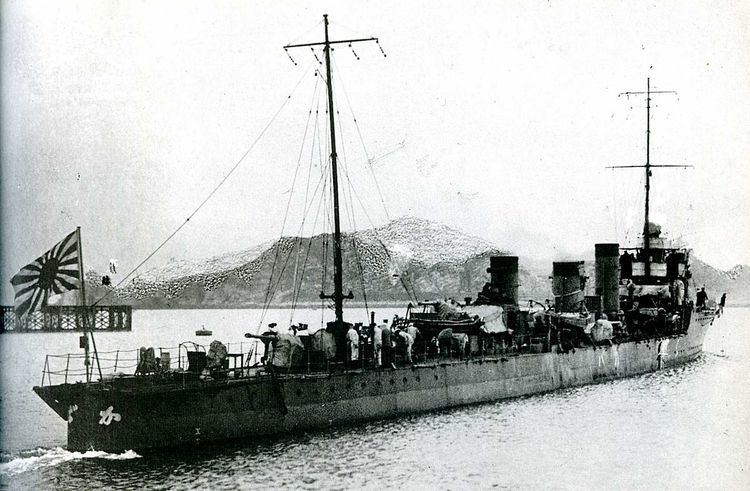Preceded by Urakaze class In commission 1915–1932 | Succeeded by Isokaze class | |
 | ||
Subclasses Arabe class (French Navy) | ||
The Kaba-class destroyers (樺型駆逐艦, Kabagata kuchikukan) were a class of ten destroyers of the Imperial Japanese Navy. Each was named after a variety of tree.
Contents
Background
At the outbreak of World War I, the Imperial Japanese Navy had a total of two modern destroyers capable of overseas deployment: the Sakura class Sakura and Tachibana. It was clear that this force would not enable Japan to fulfill its obligations under the Anglo-Japanese Alliance, so the Japanese government pushed through an Emergency Naval Expansion Budget in fiscal 1914 to allow for the construction of ten new destroyers. As speed was of the essence, the orders were given to both government and civilian shipyards (as was the case with the construction of the Russo-Japanese War vintage Kamikaze-class).
Twelve more vessels were built by the same shipyards in Japan per an order from the French Navy, where they were designated the Tribal class (or Arabe class) named Algérien, Annamite, Arabe, Bambara, Hova, Kabyle, Marocain, Sakalave, Sénégalais, Somali, Tonkinois, and Touareg. The Arabe class were the most advanced destroyers in the French inventory in World War I.
Design
The ten Kaba-class vessels were built simultaneously at eight different shipyards around Japan. As there was no time to design a new vessel, plans for the previous Sakura-class destroyers were distributed to each shipyard, with the instructions that the power plant was to be a conventional coal-fired triple expansion steam engine, and not a steam turbine.
Armament was the same as that of the Sakura class, with one QF 4.7 inch Gun Mk I - IV, mounted on the deck forward of the bridge, and four 3 inch 12 pounder guns, mounted one on either side and two towards the stern of the ship, with two torpedo launchers.
Operational history
Given the speed of construction and the fact that eight different shipyards were used, it is a tribute to the Japanese shipbuilders that all ten vessels produced were uniform in appearance and capabilities, and performed reliably in their overseas deployment to the Indian Ocean and the Mediterranean Sea in combat operations in World War I. This deployment began with Rear Admiral Kozo Sato arrived in Malta in mid-April 1917, with the cruiser Akashi as his flagship and eight Kaba-class destroyers. The Japanese fleet was nominally independent, but carried out operations under the direction of the Royal Navy command on Malta, primarily in escort operations for transport and troopship convoys and in anti-submarine warfare operations. Sakaki was damaged by the Austro-Hungarian Navy U-boat U-27 on 11 June 1917 off of Crete with the loss of 68 of her 92 crewmen. She was salvaged and repaired.
All ten vessels survived the war, and were retired on 1 April 1932.
